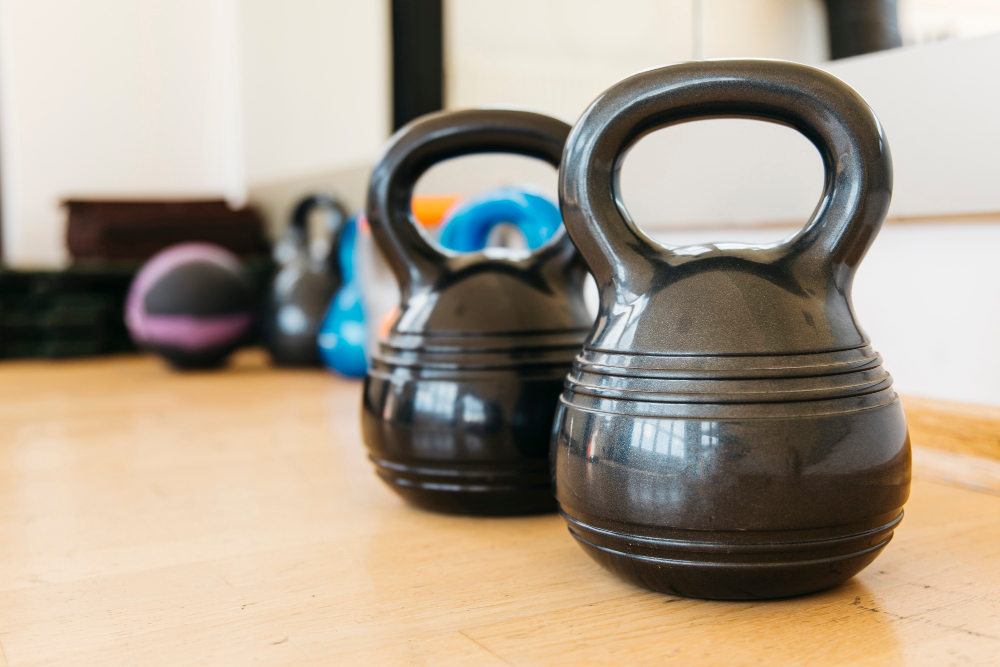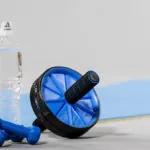Abs look good, no doubt. But a powerful core? That’s what actually makes a difference. It’s what helps you stay balanced when you sprint, pick up your kid without tweaking your back, and hold solid form when you train. A strong core means control, not just definition.
Now, when it comes to building that kind of strength, kettlebells are legit. They challenge your balance, force your core to engage constantly, and build real-world power. But most kettlebell core exercises you see online are advanced. They demand serious precision and body awareness. Not ideal if you’re just starting out.
That’s why we put together this list of kettlebell core exercises for beginners that are simple, effective, and designed to help you see results fast.
Beginner Kettlebell Core Exercises That Actually Work
If you’re a beginner, these kettlebell core exercises are a great place to start:
- Kettlebell Dead Bug
This one teaches you how to actually brace your core. You lie on your back, hold a light kettlebell above your chest with straight arms, and move opposite limbs slowly while keeping your lower back pinned to the ground.
It looks easy. It’s not. But it’ll train control, coordination, and deep core activation without any strain on your spine.
- Kettlebell Suitcase Carry
Hold the kettlebell in one hand and walk. That’s it. Your job is to stay upright without leaning or twisting.
This simple move torches your obliques, improves posture, and sneaks in grip strength and shoulder stability. It’s one of the easiest ways to build anti-rotation strength, which is what your core is actually made for.
- Kettlebell Russian Twists (With Control)
Not the fast, flailing kind you see in group classes. Sit on the floor, heels down, and slowly rotate side to side with a light kettlebell.
Control the movement. Don’t just swing the bell. This builds rotational strength and helps you learn to move from your core, not your arms.
- Kettlebell Plank Drag
Start in a plank. Place the kettlebell just outside your hand, then reach across with the opposite hand and drag it across your body. Reset and repeat on the other side.
This forces your core to resist twisting while your body shifts. You’ll also get bonus shoulder and glute activation if you stay tight.
- Kettlebell Half Get-Up
Forget the full Turkish get-up for now. The half version is all you need. You lie down, press the kettlebell up with one arm, then rise up onto your elbow, then your hand.
It builds total-body coordination, shoulder stability, and core strength from the ground up. Go slow, focus on form, and you’ll feel muscles you didn’t know you had.
Level Up: Kettlebell Core Exercises for When You’re Ready to Go Harder
Once you’ve nailed the basics and your form holds up under pressure, it’s time to level up. These advanced kettlebell exercises are the next step.
- Full Turkish Get-Up
This is the gold standard for total-body strength and core control. Every part of your body is working, but your core drives the movement.
From lying down to standing up with a kettlebell overhead, this move demands precision. Take it slow. Break it down. Own every step.
- Kettlebell Windmill
This one tests your obliques, hips, and shoulder stability all at once. With the kettlebell overhead, you hinge sideways and touch the floor with the opposite hand.
You’ll build rotational control and anti-rotation strength. Two keys to a powerful, injury-resistant core.
- Kettlebell Renegade Row
Start in a push-up position with a kettlebell in each hand. Row one bell at a time while keeping your hips level.
It sounds simple. It’s not. This move hits your lats, abs, and deep stabilizers all at once.
- Kettlebell Overhead Carry
Lock a kettlebell overhead and walk. That’s it. But everything from your core to your shoulder to your grip is under constant tension.
This move exposes any weakness in posture or control, especially when done for time or distance.
- Kettlebell Figure 8 to Hold
Pass the bell between your legs in a figure 8 pattern, then pause and hold in a squat position. It builds dynamic core strength, grip, and coordination under movement.
Expect your heart rate to spike. This is part core, part conditioning.
- Kettlebell V-Sit Press
Sit in a V-sit position and press the kettlebell overhead. Your core has to stay locked in while your arms move.
It’s a serious challenge to your stability, and you’ll feel it immediately if your form slips.
Final Thoughts
Kettlebells are one of the best ways to get a strong core. Start with the basics, train with control, and level up when your body’s ready. These moves make you more stable, more powerful, and harder to break. That’s a core that works, not just one that looks good in the mirror.
FAQ
How often should I train the core with kettlebells?
Two to three times a week is enough, especially if you’re doing full-body workouts. Core training should support your other training, not drain you.
What weight kettlebell should beginners use for core exercises?
Start light. Something between 18-26lbs (8-12 kg) works for most beginners. Focus on control before trying to go heavy.
Do kettlebell core exercises burn belly fat?
They help, but not directly. Fat loss comes from diet and overall activity. These moves will strengthen your core and help your body move better, but you’ll need to dial in your nutrition to see the abs.
Can I just do these instead of crunches and sit-ups?
Absolutely. These exercises work your core in a more functional, full-body way. You’ll get more carryover to real movement and better overall strength.





